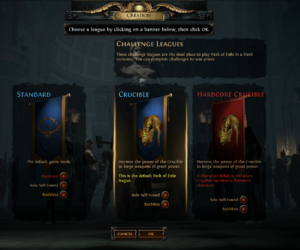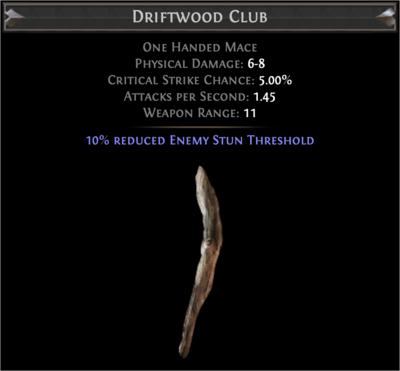User:Bloonpauper/New Player Guide
This is a guide on the subject of introducing new players to Path of Exile.
Last updated on WIP.
This is a guide for new players to Path of Exile. No previous experience in any game is required. This guide is intended to be read alongside playing the game - its contents are listed in chronological order of appearance. However, it is not a walkthrough. For those seeking an exact guide, finding a reliable content creators on youtube and following their guides is recommended. Any questions not answered by this guide are best asked on the official Discord server.
Introduction
If you are a new player to Path of Exile and play with no assistance whatsoever, likelihoods are that you are going to have a bad time. Please be aware that this is not directly due to the game's complexity or difficulty - while it does have both, the real problem is that the base game does a poor job of communicating its many mechanics.
When confronted with this informational barrier, many new players turn to a guide. Specifically, guides that tell you exactly what to do in every aspect of the game - what items to equip, what passive skills to allocate, what skills to use, etc. This approach is not necessarily bad - it may work very well for many players. However, such guides rarely give new players the space and autonomy to figure things out for themselves and make their own choices.
The purpose of this guide is to bridge that gap - it will provide you will with all the information needed to play, enjoy, and most importantly understand the game, but it will not tell you what to do.
League selection

The first choice for any new player is to choose their league. A league is effectively the world within the character operates - it is impossible to interact with players or items inbetween leagues, unless it is the character itself that is changing leagues. There are two types of leagues: permanent and challenge leagues. Standard is the main permanent league - it has been running since the game's release and will continue to run indefinitely. Challenge leagues only last for 3-4 months - they come in sequence, one after the other. For the portion of the playerbase that exclusively plays challenge leagues (the vast majority), challenge leagues represent a full reset of everything - characters, items, progression, along with the introduction of a brand-new "League mechanic".
It is recommended for first-time players to choose the current challenge league (Crucible at time of writing) and to not select the Solo Self-Found, Hardcore, or Ruthless optional gamemodes.
- Solo Self-Found (known as "SSF"): Players in an SSF league cannot join parties with other players or trade with them. Due to the presence of trading in the game's balance, SSF is significantly harder than trade leagues, especially for inexperienced players.
- Hardcore (known as "HC"): Players in an HC league will be migrated to their respective SC (Softcore) league on death.
- Ruthless: All item drops are far scarcer, many items and passive skills are significantly weaker, and many mechanics are not available. Significantly harder than non-Ruthless. For those overwhelmed by the complexity of the base game, playing in Ruthless may be advisable. Choose at your own discretion.

Class selection
Unless you are following a specific guide, there is no wrong class to choose. Path of Exile offers an unrivalled level of character customization. As a result, there are very few class-specific skills, no class-specific items, and no class-specific playstyles. Any class can do whatever they want. It is recommended to choose whatever class you want - there is no wrong choice.
The Twilight Strand
The Twilight Strand is the very first area in the game. Much of this is covered by the in-game tutorial. However, it introduces several complicated mechanics that may need further explanation.
First, pick up the weapon on the ground next to you. Each class will encounter a different weapon.
Weapon base type
Marauder receives the ![]() Driftwood ClubDriftwood ClubOne Handed Mace
Driftwood ClubDriftwood ClubOne Handed Mace
Physical Damage: 6-8
Critical Strike Chance: 5.00%
Attacks per Second: 1.45
Weapon Range: 1.1 metres10% reduced Enemy Stun Threshold![]() . It is being used here as an example to explain the individual stats of weapon base types.
. It is being used here as an example to explain the individual stats of weapon base types.

- Item name box: the colour of this box signifies the rarity of the item. White = Normal, Blue = Magic, Yellow = Rare, Orange = Unique. Rarities are discussed later.
- Base type: “
 Driftwood ClubDriftwood ClubOne Handed Mace
Driftwood ClubDriftwood ClubOne Handed Mace
Physical Damage: 6-8
Critical Strike Chance: 5.00%
Attacks per Second: 1.45
Weapon Range: 1.1 metres10% reduced Enemy Stun Threshold ”. An item’s base type determines its weapon type, base damage, base critical strike chance, base attack speed, base weapon range, and implicit(s).
”. An item’s base type determines its weapon type, base damage, base critical strike chance, base attack speed, base weapon range, and implicit(s).
- Weapon type: One-Handed Mace. An item’s weapon type determines it compatibility with certain skill gems and support gems, as long with its modifier pool.
- Base damage: 6-8 physical damage. Attacks with this weapon will use this as their base damage. Generally, this is the most important stat for attack weapons.
- Base critical strike chance: 5.00%. Attacks with this weapon will use this as their base critical strike chance.
- Base attack speed: 1.45 attacks per second. Attacks with this weapon will use this as their base attack speed.
- Implicit modifier: 10% reduced Enemy Stun Threshold. Some base types have implicit modifiers inherent to them.
 Driftwood ClubDriftwood ClubOne Handed Mace
Driftwood ClubDriftwood ClubOne Handed Mace
Physical Damage: 6-8
Critical Strike Chance: 5.00%
Attacks per Second: 1.45
Weapon Range: 1.1 metres10% reduced Enemy Stun Threshold ’s implicit modifier reduces the amount of damage needed to be taken by enemies for them to be stunned.
’s implicit modifier reduces the amount of damage needed to be taken by enemies for them to be stunned.